Insects & Spiders
Insects are arthropods (Gk. jointed limbs). They have a hard exoskeleton, jointed legs, and a three-part body (head, thorax, and abdomen). Insects are the most diverse group of animals and make up over 50% of all known organisms. Spiders are also arthropods. Spiders have eight legs, two body segments (cephalothorax and abdomen) and fangs that inject venom. The abdomen of a spider contains spinnerets that extrude silk strands when they spin webs.
Featured Insects and Spiders: Red Fire Ant, Bumblebee, Carpenter Bee, Ebony Jewelwing (Damselfly), Harvestman (Daddy Longlegs), Painted Skimmer (Dragonfly), Eastern Tiger Swallowtail Butterfly, Phantom Crane Fly, Silver-Spotted Skipper Butterfly, Orb-Weaver Spider
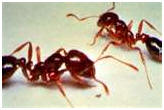 Red Fire Ant Solenopsis invicta Stinging ants that build mound-shaped colonies in open areas. Eat mostly plants, seeds, and sometimes crickets. More info |
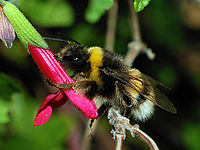 Bumblebee Bombus spp. Big-bodied and social insects. Feed on nectar and pollen. Often live in underground tunnels in colonies of fewer than 50 individuals. |
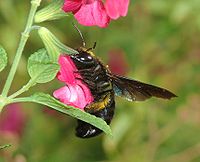 Carpenter Bee Xylocopa virginica Bore tunnels into wood (to include porches) to build nests. Carpenter bees do not eat wood. Eat nectar and pollen. Often mistaken for a bumblebee. Males do not have stingers, but females do. Not aggressive and seldom sting. |
 Ebony Jewelwing (Damselfly) Calopteryx maculata Eat flies, mosquitoes and other small insects. Found near rivers and streams. |
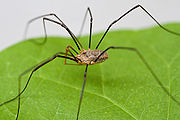 Harvestman (Daddy Longlegs) Phalangium opilio Eight-legged invertebrates related to spiders. Harvestmen have no venom, fangs or silk glands. Not dangerous to humans. Legs twitch when broken off to distract predator as they escape. Eat small insects, carrion, plant material. |
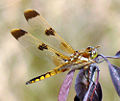 Painted Skimmer (Dragonfly) Libellula semifasciata Dragonflies and damselflies are similar. Dragonflies hold their wings straight out when they rest, whereas damselflies hold their wings against their bodies. Dragonflies have legs, but cannot use them for walking. Eat mosquitoes, flies, bees, ants, butterflies. Found around lakes, ponds, streams, and wetlands. |
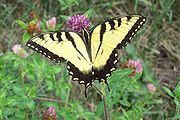 Eastern Tiger Swallowtail Papillio glaucus Tiger-like yellow and black stripes on wings. Lay single round egg on top of a leaf (tulip trees are one of favorite host trees). Caterpillar looks like a bird dropping. Caterpillar eats leaves. One of the most common butterflies. Feed in groups and take nectar from a wide range of flowers. Found in woodland clearings, gardens, parks, orchards, and along roads and rivers. |
 Phantom Crane Fly Bittacomorpha clavipes Weak fliers that appear to wobble as they fly. Fragile legs are shed if bitten by a predator. Crane flies do not bit humans. Adults feed on nectar or not at all. Most adults live long enough to mate and then they die. Females lay eggs in soil or rotting wood before they die. Eggs hatch out into worm-like larvae that feed on roots, fungal threads, decaying vegetation, and mosses. Larvae metamorphose into short-lived winged adults. Found by water or among damp vegetation in shaded woodlands. |
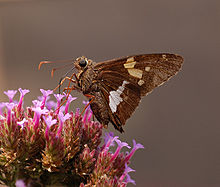 Silver-Spotted Skipper Epargyreus clarus Butterfly that frequents fields and forest edges. Skippers are sometimes mistaken for moths. Skippers are fast fliers that tend to go in erratic patterns. Moths are different from butterflies. Most moths are nocturnal and attracted to lights. Butterflies are active during the day. Butterflies have slender antennae with a club-shaped end. Moths have antennae that are feathery and unclubbed. Butterflies tend to be brightly colored whereas moths tend to be drab in order to provide camouflage as they rest during the day. Moths tend to have fat bodies, whereas butterflies are relatively slender. Moths tend to rest with their wings spread, whereas butterflies rest with their wings folded up. |
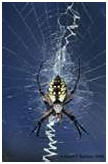 Orb-Weaver Spiders (Family Araneidae) Orb-weaver spiders are those that build flat webs with concentric spirals of sticky silk. The webs "filter" the air of insects that become entrapped in the sticky web. Spiders walk to prey on dry strands of silk that are not sticky. Prey are quickly bitten by fangs (chelicerae) and injected with venom that paralyzes and kills them. While the venom is working, the prey is wrapped in silk. Once dead, spiders inject digestive enzymes into the bodies of their prey that liquefies internal organs. This is a type of external digestion in that it occurs outside of a spider's body. Spiders then suck out the nutrient-filled liquid leaving an empty carcass behind. Spiders have small guts that cannot accept solid food. Spiders don't chew food. |
||
|
|
